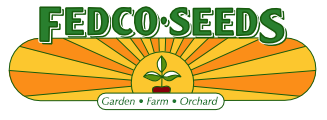Editorials
Welcome to Fedco’s 44th Year!
It’s been more than two decades since Gary Nabhan first challenged himself to get all his food from within a 250-mile radius in Arizona. This idea was picked up by James MacKinnon and Alisa Smith, who narrowed their scope to 100 miles around Vancouver, and then by Barbara Kingsolver, who focused on eating only what she had grown in Appalachia. From these trailblazers the term locavore came into the vernacular, and we started to learn the litany of all that has gone wrong with the industrial-food system: that much of our food comes from 1500–3000 miles away, depleting aquifers for irrigation, using fossil fuel to run large machinery, exploiting workers, and using more fossil fuel for transport. That distance also obscures the specificity of one’s particular breakfast melon, with many a child thinking it originates in the supermarket.
In Maine we are fortunate to have the Maine Organic Farmers and Gardeners Association to advocate for local food. Food “with a face, a taste and a place” is a common lens through which we understand our food networks. But what about our seed?
Silvia Davitz, the Vermont customer who recently provided us with stock seed, once advised, “The logical next step for the local food movement is to establish locally grown seeds.” For seed is the foundation of food, and we will have no food security until we develop our relationship with seed. Canada’s Bauta Family Initiative has understood this from its inception, investing in small-scale seed farmers. Across the pond, folks in the UK and Ireland just held their first Seed Gathering where the excitement was palpable as people took seed back into their own hands, even while grappling with the law that allows only “registered” seed in the marketplace.
It once was common wisdom that local seed is resilient seed, developed in concert with local conditions—rainfall amounts, temperature fluctuations, seasonal length, pests, diseases. Local seed doesn’t depend on as much fossil-fuel transport or supply-chain vagaries, both of which are starkly inescapable problems we face today.
In our continuing exploration of one of Fedco’s foundational queries—“Do you know where your seed comes from?”—we are focusing in on seed grown closer to home, as well as sketching a typical vignette of one seed from each of our numeric Supplier Codes. Admittedly it’s only a snapshot, but we hope to provide a bit of good information for you to make better choices as a global citizen of Gaia, putting down roots in your own backyard.
May you and your gardens thrive in the year to come, growing in beauty, durability and resilience! And may we all dig a bit deeper.
– Nikos Kavanya
Seed Industry Updates
The seed supply chain has its problems, and for several years we have highlighted within the pages of this catalog many small but potent solutions that have sprung up in our communities. We think grassroots projects are where our collective energy is most effectively spent: rebuilding a model that holds at its core respect for diversity, life, sovereignty and human rights. But big issues lurk in the weeds, and we need to call out a few:
Buyers Beware!
Monsanto/Bayer has just announced it will start marketing organic seed in 2022, focusing on tomatoes, peppers and cucumbers to start. Expect that some of the organic seed sold by our competitors will be from Monsanto. Know where your seed comes from!
Terminator Technologies
The fact that Bill Gates is the largest farmland owner in the U.S. should give us pause. Absentee landlord/contract farmland means the landowner gets paid even when the farm crop fails. The rich keep getting richer. Same old same old.
In addition to investing in Impossible Foods (bringing a GMO burger somewhere near you), Gates bankrolls gene drive extinction technology. Say what? This relatively new CRISPR gene-editing technology is freshly framed to eliminate the malaria-causing mosquito in Africa. It’s a PR bonanza: mosquitos = bad; malaria = bad; helping Africa = good. But I’m old enough to remember how the last anti-mosquito campaign involved spraying DDT in my neighborhood.
Experimenting with gene drive extinction technology has provoked significant alarm among ecologists and biosafety experts. The planet is already facing a wave of extinctions of both animals and plants. Almost half of all insect species have become extinct in the last 30 years. The potential of chain-reaction collapse is worrisome, with risks of unintended consequences to ecosystems, as well as of dangerous misuse of gene drive technology. When you eliminate a species, what happens to the natural web it belonged to? And who has oversight over any of this?
What does this have to do with seeds? Terminator Technology (seeds passing on their sterility so any seeds produced are not viable) still lurks around the corner. CRISPR technology is part of the ongoing agricultural discussion, approved by the USDA and so no longer regulated.
Eat Your Vaccines?
A customer brought to our attention research being done at the University of California-Riverside, where scientists are trying to turn edible plants into mRNA vaccine factories. “We are testing this approach with spinach and lettuce and have long-term goals of people growing it in their own gardens,” said UCR associate professor Juan Pablo Giraldo, who is leading the research. “Farmers could also eventually grow entire fields of it.... Ideally, a single plant would produce enough mRNA to vaccinate a single person.” Let’s recall that haunting line from Jurassic Park: “If there’s one thing the history of evolution has taught us, it’s that life will not be contained. Life breaks free, it expands to new territories, and crashes through barriers painfully, maybe even dangerously, but, uh, well, there it is.”
Read all about it!
Two websites we recommend to keep up with the rapidly changing landscape:
- Let’s Liberate Diversity
Their mission is to encourage, develop and promote the dynamic management of cultivated biodiversity on farms and gardens. Their motto: Use it or lose it. - Erosion, Technology and Concentration Group
ETC Group’s stated goal is to monitor power, track technology and strengthen diversity. Their reporting is like nothing you’ll find in the usual media outlets. Their paper “A Long Food Movement: Transforming Food Systems by 2045” has much food for thought.
– Nikos Kavanya, Seeds purchaser
Supplier Code Vignettes: Who Supplies Our Seed?
Supplier Code 1 – Small seed farmers including Fedco staff.
Maine Sunset Bean ECO: Chirp Creek Farm
This Maine heirloom dates back to at least the 1930s. It was first introduced to us by Pearl Smith of Unity, ME, who had been maintaining the seed. We sold the variety for a few years until a string of crop failures depleted our stock. This year we had enough seeds to pass along to Ben Daley at Chirp Creek Farm, in Lisbon, ME, 56 miles from Fedco. Ben grew them out for us, and we went to visit him and the beans in mid-August. This fall, after his beans dried down, he harvested the plants, separated the seeds and brought them to our warehouse. Ben is a typical Supplier Code 1 grower. We have personal relationships with these growers. Some of them grow a small amount of one variety in their backyard gardens, some of them work at Fedco. We know the most about these seeds, and many carry stories we can trace back decades.
Supplier Code 2 – Family-owned companies or coops, domestic and foreign.
Galeux D’Eysines Squash Organic: AP Whaley Seed Company, LLC
Sometimes called Peanut squash, Galeux D’Eysines is an old French heirloom, hailing from the Bordeaux region of France. We purchase our seed from A. P. Whaley, based in Mount Horeb, WI. It is a family-owned and -operated business that wholesales seeds, what we consider Supplier Code 2. Each summer they grow many sizable crops for seed in Wisconsin; however, the bulk of their seed production is done in California, Colorado, Idaho, Chile and Europe. We do not know where these squash seeds are grown.
Supplier Code 3 – Domestic and foreign corporations not part of a larger conglomerate.
Lincoln Pea: Kimberly Seeds International
Fedco buys our Lincoln pea seed from Kimberly Seeds, based in Kimberly, ID. They sell pea, bean and corn seed to the international wholesale market. We consider this larger corporation a Supplier Code 3. All of their peas are grown by an experienced network of farmers in the Magic Valley in southern Idaho, a region known internationally as ideal for growing pea and bean seed because of its great soils, dry climate, long warm days and cool evenings, and water access from the irrigation systems fed by the Snake River. With wild fires, rising temps and drought, man-made climate change is compromising these growing conditions.
Supplier Code 4 – Multinationals not to our knowledge engaged in genetic engineering.
Darkibor Kale: Bejo
This super-curly kale is an F-1 hybrid, meaning it has two distinct parent lines that were crossed to make Darkibor. Each year these undisclosed parent lines are grown and maintained separately and then routinely crossed to maintain the Darkibor variety. We buy Darkibor Kale seed from Bejo, based in Oceano, CA—we consider this multinational corporation a Supplier Code 4. We do not know where they grow Darkibor, but typically Bejo grows seed in the U.S. then sends it back to the parent company in Holland for quality assessment.
Supplier Code 5 – Multinationals who are engaged in genetic engineering.
Wave Series Petunias: PanAmerican Seed
The Wave petunia come from an unlikely source. In the early 1990s folks at the Japanese beer company Kirin noticed these wild petunias growing abundantly in their fields. The low- growing wide-spreading habit attracted PanAmerican Seed, which partnered with Kirin to develop and distribute the flower. Wave Purple was widely introduced to American home gardeners in 1995 when it won a coveted All-America Selection. More colors have been bred since. When we were introduced to Wave Purple, we triple-checked that it was not genetically engineered because it was so unusual! Although this F-1 hybrid is not GM, PanAmerican, an international breeder and producer of flower seed based in the Netherlands, does engage in genetic engineering—we identify it with a Supplier Code 5. We do not know where they grow the Wave petunia seed.
Supplier Code 6 – Syngenta, manufacturer of neonicotinoids.
Athena Melon: Syngenta
Athena is known as an “industry standard” in the eastern U.S. because of its sweetness, high yield and shipping ability. Fedco buys Athena seed from Syngenta, which we identify with a Supplier Code 6. Syngenta Group is a global provider of agricultural science and technology, in particular seeds and pesticides, herbicides, fungicides and fertilizer. Its headquarters is in Basel, Switzerland, with locations in Chicago, Tel Aviv and Shanghai. Syngenta AG was founded in 2000 by the merger of the agrichemical businesses of Novartis and AstraZeneca, and acquired by ChemChina in 2015. In 2020, the Syngenta Group was formed, bringing together Syngenta, Adama and the agricultural business of Sinochem under a single entity. Also in 2020, the Syngenta group purchased Hollar Seeds, previously a family-owned business, which Fedco buys seed from.
Curiously, in Fedco’s contract with Syngenta, we must sign a clause that we will not sell Athena melon seed to growers in South Carolina. In 2012 an outbreak of listeria was linked to Athena melons grown by several farms in SC. Although listeria is caused by bacteria entering the melon and has nothing to do with the seed, this group of farmers sued Syngenta. Syngenta responded by restricting their distributors from selling this variety in the entire state of South Carolina.

